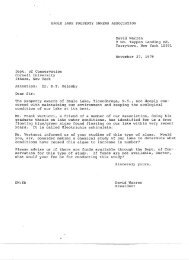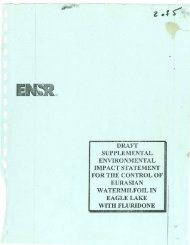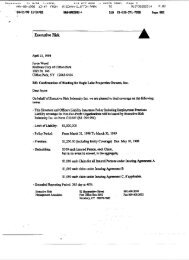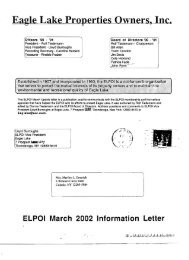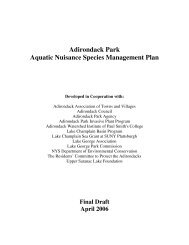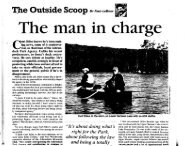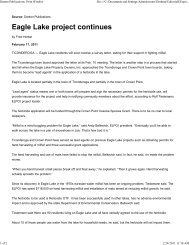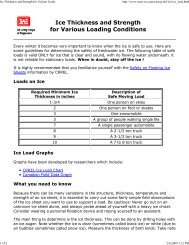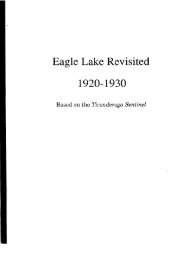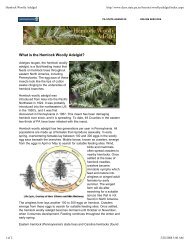Maine Field Guide to Invasive Aquatic Plants - Brant Lake Milfoil ...
Maine Field Guide to Invasive Aquatic Plants - Brant Lake Milfoil ...
Maine Field Guide to Invasive Aquatic Plants - Brant Lake Milfoil ...
You also want an ePaper? Increase the reach of your titles
YUMPU automatically turns print PDFs into web optimized ePapers that Google loves.
B A C K G R O U N D<br />
P L A N T C O M M U N I T I E S<br />
Most aquatic plants are found in the near<br />
shore portions of the waterbody where<br />
sunlight penetrates <strong>to</strong> the bot<strong>to</strong>m sediments.<br />
This portion of the lake, pond or stream is<br />
called the lit<strong>to</strong>ral zone. As water clarity and<br />
the bathymetry vary widely from one<br />
waterbody <strong>to</strong> another, the outer depth of the<br />
lit<strong>to</strong>ral zone also varies. The plants that grow<br />
in the lit<strong>to</strong>ral zone can be conceptually<br />
grouped in<strong>to</strong> distinct communities. In reality,<br />
however, there is a good deal of overlap<br />
between communities.<br />
EMERGENT PLANT COMMUNITY: This area<br />
extends from the wet shoreline soils in<strong>to</strong><br />
relatively shallow (knee-deep) water. With stiff<br />
but buoyant leaves and <strong>to</strong>ugh interlocking<br />
roots, emergent plants are well adapted <strong>to</strong><br />
life at the water’s edge where wave action<br />
and fluctuating water levels are common. The<br />
plants in this community play an important<br />
role in protecting water quality by preventing<br />
shoreline erosion and the resuspension of<br />
fine bot<strong>to</strong>m sediments. They also provide<br />
important food and cover for insects, fish<br />
and waterfowl. Native plants commonly<br />
found in the emergent plant community<br />
(also referred <strong>to</strong> as “wetland” plants) include:<br />
cattails, arrowheads, pickerel weed, sedges<br />
and rushes.<br />
Emergent Plant<br />
Community<br />
Though there are invasive emergent plant species that threaten <strong>Maine</strong>’s<br />
wetlands, none is currently prohibited by law as are the eleven aquatic<br />
plants on <strong>Maine</strong>’s invasive aquatic plant list. Information on three of<br />
these invasive wetland species is presented on page 123.<br />
FLOATING-LEAVED Plant Community: This area extends from<br />
the wet shoreline <strong>to</strong> chest deep water. <strong>Plants</strong> in this group are<br />
distinguished by <strong>to</strong>ugh, waxy leaves adapted <strong>to</strong> float on the surface<br />
of the water. Some floating-leaved plants have long, elastic leaf stalks<br />
extending <strong>to</strong> the bot<strong>to</strong>m sediments. Others are free-floating. Native<br />
plants commonly found in this community include: fragrant waterlilies,<br />
watershield, spatterdock, and little floating heart. Three of the eleven<br />
invasive aquatic plants on <strong>Maine</strong>’s list are found in this community:<br />
European frogbit, yellow floating heart, and water chestnut.<br />
<br />
<strong>Maine</strong> Volunteer <strong>Lake</strong> Moni<strong>to</strong>ring Program



